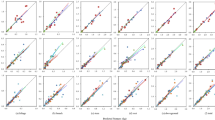Abstract
We examined the effects of climate and allocation patterns on stem respiration in ponderosa pine (Pinus ponderosa) growing on identical substrate in the cool, moist Sierra Nevada mountains and the warm, dry, Great Basin Desert. These environments are representative of current climatic conditions and those predicted to accompany a doubling of atmospheric CO2, respectively, throughout the range of many western north American conifers. A previous study found that trees growing in the desert allocate proportionally more biomass to sapwood and less to leaf area than montane trees. We tested the hypothesis that respiration rates of sapwood are lower in desert trees than in montane trees due to reduced stem maintenance respiration (physiological acclimation) or reduced construction cost of stem tissue (structural acclimation). Maintenance respiration per unit sapwood volume at 15°C did not differ between populations (desert: 6.39 ± 1.14 SE μmol m−3 s−1, montane: 6.54 ± 1.13 SE μmol m−3 s−1, P = 0.71) and declined with increasing stem diameter (P = 0.001). The temperature coefficient of respiration (Q 10) varied seasonally within both environments (P = 0.05). Construction cost of stem sapwood was the same in both environments (desert: 1.46 ± 0.009 SE g glucose g−1 sapwood, montane: 1.48 ± 0.009 SE glucose g−1 sapwood, P = 0.14). Annual construction respiration calculated from construction cost, percent carbon and relative growth rate was greater in montane populations due to higher growth rates. These data provide no evidence of respiratory acclimation by desert trees. Estimated yearly stem maintenance respiration was greater in large desert trees than in large montane trees because of higher temperatures in the desert and because of increased allocation of biomass to sapwood. By analogy, these data suggest that under predicted increases in temperature and aridity, potential increases in aboveground carbon gain due to enhanced photosynthetic rates may be partially offset by increases in maintenance respiration in large trees growing in CO2-enriched atmospheres.
Similar content being viewed by others
Author information
Authors and Affiliations
Additional information
Received: 4 November 1996 / Accepted: 23 January 1997
Rights and permissions
About this article
Cite this article
Carey, E., Callaway, R. & DeLucia, E. Stem respiration of ponderosa pines grown in contrasting climates: implications for global climate change. Oecologia 111, 19–25 (1997). https://doi.org/10.1007/s004420050203
Issue Date:
DOI: https://doi.org/10.1007/s004420050203




